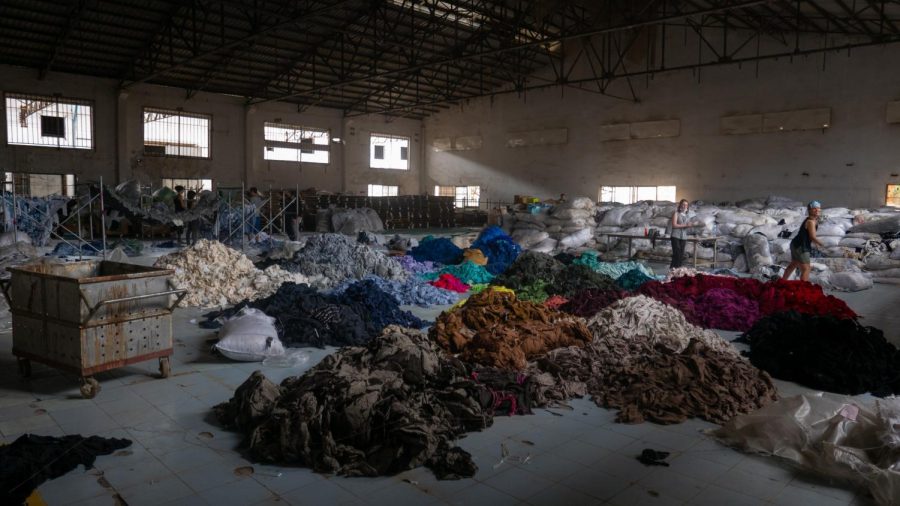The truth behind fast fashion
Abandoned clothing found in Cambodian factory that was eventually used in a political art piece by Clothing the Loop. Francois Le Nguyen/unsplash
May 18, 2021
Commonly, stores such as Forever 21 sell garments that can cost as little as a Happy Meal. One might wonder, how can a shirt be so inexpensive in this day and age? The truth is that large manufacturers hide the real cost of the clothing they produce through their harsh advertising, cruel treatment of garment workers, and lack of concern for the environment.
This is why it is important to acknowledge the negative impacts that fast fashion has on modern society.
Fast fashion companies purposely manipulate us to buy more. Frequently, they prey on our insecurities, focusing on the fragile confidence of young girls. Rimi Khan, a research fellow in the School of Culture and Communication at the University of Melbourne, depicts the fast fashion industry as being specifically aimed towards, “a young, trend-conscious female market.” Teenagers are often susceptible to facing extreme issues with self esteem, so if a company can make a product that temporarily solves these problems, this audience will most likely jump at the chance to buy it.
However, it isn’t the teenage girls of America that are most jeopardized by this epidemic. It is the people producing these items that are at risk. Specifically, Asian garment workers experience high levels of verbal, physical, and sexual harassment in the workplace. WIEGO, an organization whose purpose is to improve the status of working poor women, supports the idea that it is not easy to escape these environments for, “In many countries, the garment industry is the largest employer in manufacturing.” Even in America, a place where such corrupt treatment of workers may seem rare, an estimated 85% of garment workers aren’t even paid minimum wage to work in the harsh conditions of clothing factories.
While the concerns of harsh advertising and deplorable garment factory conditions are very critical outcomes of fast fashion, the most serious might be the impact fast fashion has on the environment. This is because the effects of fast fashion in the environment are irreversible, and with the annual increase in the fast fashion market, the point of no return nears closer everyday. Planet Aid states that, “26 billion pounds of clothing and textiles end up in the landfill each year, yet about 95 percent of those could be reused or recycled.” This elaborates on the notion that there is more we all can do to minimize the consequences of fast fashion.
There are many logical solutions major companies like Forever 21 and TopShop could make in order to be more ethical. Nevertheless, many of these companies have yet to make withstanding policies to diminish harsh factory conditions and waste. So in the meantime, it is important that the largest contributors to the demand in this market take control of their actions.
One solution that is pretty common and has been a staple in many lower income households over the past century, is thrift shopping. Thrift stores offer a large range of clothing at inexpensive rates. Buying second hand clothing does not hurt the environment because the thrifter is repurposing something that would have otherwise ended up in the landfill. Thrift shopping is one of the most realistic solutions because it is so cheap, unlike buying new clothing from ethical brands. Thrifting may be even more popular than some people realize. In 2017, “40 percent of 18-24 year olds shopped resale.” But like everything, as the popularity progresses, so do the implications.
Recently, many influencers on platforms such as Tik Tok have become progressively upset over the number of people buying seemingly unnecessary clothing from thrift stores. Young trend conscious people have turned to apps like Depop to resell vintage pieces at double or even triple the price they paid. There is concern that thrifting can impact communities that financially rely on this method of shopping. However, Planet Aid states that, “the supply of clothing to fill the racks is not necessarily dwindling as a result.” Planet Aid also adds that the amount of clothing available in thrift stores may in fact be growing instead as Americans buy more and more clothes each day.
Having said this, there are still ways to shop ethically while being aware of people who are threatened by the new wave of sustainable shoppers. Thrifters of a higher socioeconomic standing can make sure to thrift their clothing from companies that allow people of a lower income to go through the clothing first. Another way to be a mindful thrifter is to support companies that reinvest money into the development of poor communities around them.
Even if buying thrifted clothes is too far out of the comfort zone for some people, and ethical brands are too expensive, it is important that we all moderate our intake of these wrongly produced clothing.








